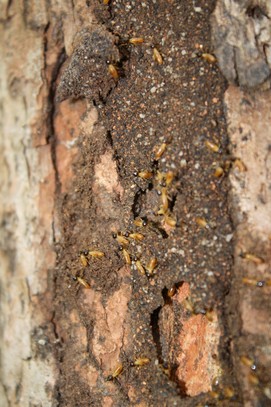Frequently Asked Questions on Termites, Termite Inspections and Termite Treatments
How do termites get into my home?
Houses provide termites with all the ideal conditions combining warmth, moisture and a plentiful food source. Termites access homes via the stumps (concrete or timber), footings and concrete steps, and can access cracks in slabs or footings as small as 0.8mm. They love damp areas such as hot water systems and air conditioners and leaking gutters.
What are the signs of a termite problem?
Signs of termite infestation can include:
Flying termites: in the warmer weather swarms of flying termites can be seen. They are sometimes mistakenly thought to be flying ants or moths. This will occur over a brief period, usually from late October, and is a sign that a termite nest may be close by. Termites swarm in order to mate and establish new colonies. Should you experience a swarm of termites inside your home, you should contact a termite technician immediately, as this can be a warning sign that you have a termite infestation.
Inside the house: Skirting boards, architraves, and timber door and window frames which may have blistered or bubbled paint, soft timbers, rippled or bulging wall linings.
Outside the house: Mud galleries (small mud tunnels) against the walls or stumps, over concrete slab edges, brickwork or foundations posts.
I live in a new house or a slab house. Is there a termite risk?
Yes, termites don't discriminate between new or old buildings. In some cases newer buildings may be at higher risk due to the type of construction, timbers used in the frame construction, termite pressure and whether or not the building was treated at construction. Never assume your building has been treated, ask your builder or council for this information.
Owners of slab-constructed buildings make the mistake of thinking they are protected because they live on a slab. This is a half-truth. Termites cannot eat through a concrete slab, however they can access building timbers via the slab rebate or pipe penetrations such as shower bases, and cracks and joins in the slab. If a slab building has been infested sometimes treatment can be problematic as termite entry points can be difficult to find and treat.
Are termite sprays safe?
Termite spraying or soil treatments have changed a great deal since 1995 when Organochlorins were banned. The termite sprays used by Termite Tactics are registered for use in domestic termite control. We use only pyrethroid based termiticides, which are found in common household insecticides, or water based solutions which are low-odour. Our preferred termite spray is Termidor and the active ingredient in this termite spray is also used in flea products for dogs.
How long does a termite treatment last?
The effective life of a termite treatment depends on the termiticide (pesticide) used, termite pressure, building construction methods and soil types. The manufacturers of the termiticides suggest re-application between 3 to 5 years, however, there is no guarantee that the termiticide will last for that period, as the factors above play a large part in the effective life of the termiticide.
Routine inspections are required at least annually to identify any new termite activity, as no treatment can be relied upon to provide 100% protection for any definite time frame.
How are the termiticides applied?
With termite treatments, it is not the timbers that are treated, it is the soil around a building, or in the case of termite dusting, it is the termite themselves that are treated.
For a soil treatment, the site is prepared and then a liquid termiticide is applied to the soil using a procedure called "flooding". This involves using a long handled wand to apply the termiticide in a steady stream directly to the soil, much like using a garden hose and wand to water plants directly at ground level.
In dusting type treatments, termiticide dust is applied into the timbers in which termites are present, but it is not actually the timbers that are being dusted. The termites will collect the dust and take it back to their nest, with the aim of introducing the termiticide dust to the colony.
What else can be done?
Termite Tactics is an authorised installer of the Exterra Baiting System. This offers a non-toxic alternative to soil treatments.
What can I do to take a proactive approach to termite control?
Your best defence against termite attack is to have regular inspections, at least annually, and to apply a soil treatment. This is a comprehensive plan with the soil treatment providing a treated zone around your home to try and deter termite access, and regular inspections which will identify any new termite activity or areas where the soil treatment may have been disturbed due to work around the home such as plumbing or landscaping activities. You can then address any new issues quickly and take corrective measures before major termite damage occurs. Some people may choose to undertake regular termite inspections only.
